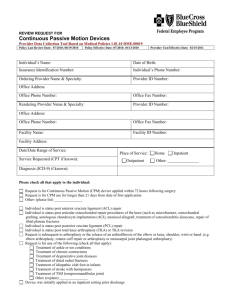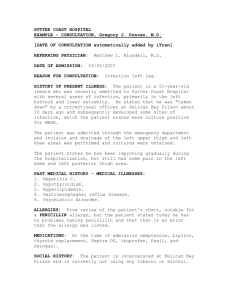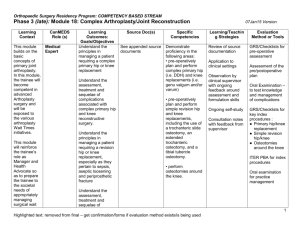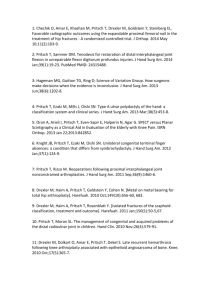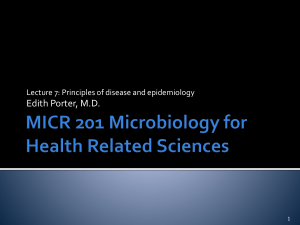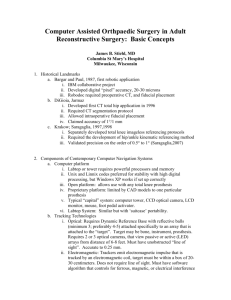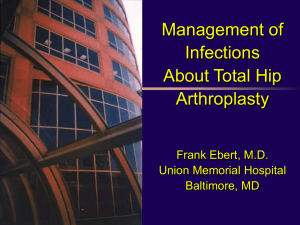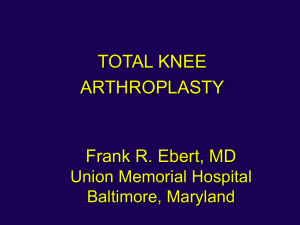Document
advertisement
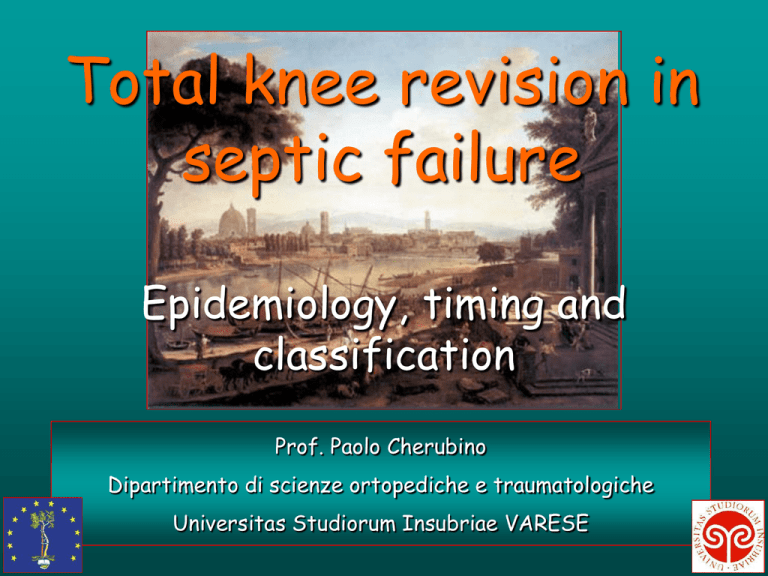
Total knee revision in septic failure Epidemiology, timing and classification Prof. Paolo Cherubino Dipartimento di scienze ortopediche e traumatologiche Universitas Studiorum Insubriae VARESE Epidemiology The most commons causes of knee arthroplasty revisions: • Infections (25.2%) • Mechanical failure (16.1%) The Epidemiology of Revision Total Knee Arthroplasty in the United States Kevin Bozic, MD. 2007 Epidemiology Risk factors The systemic risk factors: •rheumatoid arthritis •diabetes •IRC •obesity •advanced age •debilitation •oral steroids •cancer/chemotherapic treatment •immunocompromised patients Simmons TD, Stern SH. Diagnosis and management of the infected total knee arthroplasty. Am J Knee Surg. 1996 Epidemiology Risk factors The local risk factors are : •Previews knee surgery •Skin complications after the implant •psoriatic skin ulcers Simmons TD, Stern SH. Diagnosis and management of the infected total knee arthroplasty. Am J Knee Surg. 1996 Infection is actually, rare but serious problem in joints arthroplastic surgery Epidemiology INFECTION RATE AFTER TOTAL KNEE ARTHROPLASTY 0,5 - 5% • Grogan J. Bone Joint Surg. Am.1986; 68:226-34 • Wilson J.Bone Joint. Surg. Am. 1990; 72:878-83 • Bengston Acta Orthop Scand. 1991; 62(4):301-11 • Rand JA. Orthop Clin North Am. 1994. Epidemiology “The prevalence of infection after primary total knee arthroplasty has been reported to range from 0.5 to 5 percent.” J Bone Joint Surg Am. 1999 Oct;81(10):1434-45. Epidemiology “Current infection rates are in the 1% to 2%.” The Journal of Arthroplasty Vol. 19 No. 4 Suppl. 1 2004 Epidemiology A. W. Blom, J. Brown, A. H. Taylor, G. Pattison, S. Whitehouse, G. C. Bannister 2004 “Our known infection rates of 1% after primary and 5.8% after revision TKA are comparable with published reports.” Epidemiology 2007 “Deep infection rates in total knee joint replacement vary in the published literature between 0.3% and 2.9%.” HSSJ (2007) 3: 159–163 Epidemiology “Incidence rates for primary TKA between 1995 and 2004, from 6.3 to 11.0 at a rate of 5.1% per year (p < 0.001).” Etiology Pre and intra-operative pathogen ISOLATION Staph E. Gram - Staph. A. Streptococcus E. Coli Legionella P. Etiology The Journal of Arthroplasty Vol. 19 No. 4 Suppl. 1 2004 Etiology A. W. Blom, J. Brown, A. H. Taylor, G. Pattison, S. Whitehouse, G. C. Bannister 2004 Etiology J Bone Joint Surg Am. 1999 Oct;81(10):1434-45. Etiology Chang Gung Med J. 2008 Nov-Dec;31(6):583-91. Clinical-temporal classification • Immediate: before 4 weeks • Early: between 4 wks to 2 years • Delayed: over 2 years • Occasional: positive culture in replacement Segawa et al. JBJS, 1999 Classification Coventry’s state Step Zero = Operating contamination (positivity of at least 2 of 3 buffers intra-op) Step I = Acute infection post-operative (within 3 months after) Stage II = delayed deep infection (3 to 24 months after) Stage III = late hematogenous infection (a distance of years) Coventry MB. Orthop Clin North Am. 1975 Oct;6(4):991-1003. Classification J Bone Joint Surg Am. 85-A · SUPPLEMENT 1 · 2003 Therapeutic option Choice of treatment is based on: anatomical-clinical microbiological Accurate diagnostic grading Replacement-Timing • • • CBC, VES and PCR instrumental and clinical Preoperative aspiration culture Clinical orthopaedic and related research n345, 1997 Therapeutic option • Arthroscopy • Toilette • Replacement • Arthrodesis • Resection - arthroplastic • Amputation Purpose of surgery infection eradication save joint function IMMEDIATE INFECTION Toilette + Suppressive antibiotic therapy (at least 3 wks) EARLY INFECTION open surgery or arthroscopic TOILETTE + Suppressive antibiotic therapy (at least 3 wks) LATE INFECTION Remove implant and Surgical debridement age, general conditions, indication ARTHRODESIS REIMPLANT One stage Two stage INFEZIONE TARDIVA Remove implant and Surgical debridement age, general conditions, indication ARTHRODESIS REIMPLANT One stage Two stage Therapeutic option The two-stage exchange procedure has evolved as an effective treatment option. Clin Orthop Relat Res. 2007 Nov;464:164-78 Therapeutic option The best results of treatment of an infected TKR have been reported by Windsor et al in which no spacer was used between stages Windsor RE, Insall JN, Urs WK, Miller DV, Brause BD. Two-stage reimplantation for the salvage of total knee arthroplasty complicated by infection: further follow-up and refinement of indications. J Bone Joint Surg [Am] 1990. Therapeutic option Treatment of TKA infection with a twostage exchange had a significantly better outcome than debridement with retention of the prosthesis. Good results were obtained with two-stage revision of infected TKA International Orthopaedics (SICOT) 2008 Therapeutic option Two-stage reimplantation of an infected total knee arthroplasty using a static antibiotic-cement spacer achieved an infection control rate of 86% and improvement in the clinical results. #1 F, 75 aa PM S. Aureus PREOP #1 F, 75 aa PM S. Aureus ESP #1 F, 75 aa PM S. Aureus ESP #1 F, 75 aa PM S. Aureus F-U 1 anno #2 F, 78 aa IS Serratia marcescens PREOP #2 F, 78 aa IS Serratia marcescens ESP #2 F, 78 aa IS Serratia marcescens ESP #2 F, 78 aa IS Serratia marcescens F-U 3 anni
